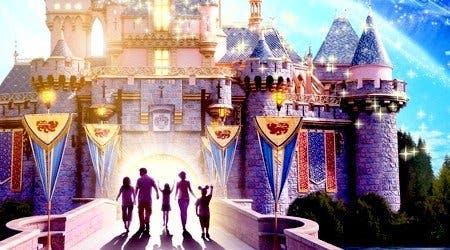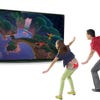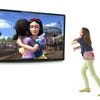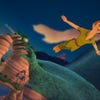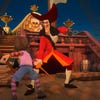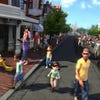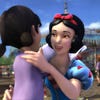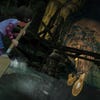Kinect: Disneyland Adventures Review
Parklife.
Amongst the dozens of things that video games and Disneyland have in common - a fascination with sight lines, a focus on visual progression and fantastical architecture - is an overabundance of non-player characters. I should know. A few years back, I was one of them.
For a few short weeks towards the end of the 1990s, I worked at Disneyland. It's the reason I can put pirate alongside barista, insurance clerk and mailroom boy on my CV.
My tenure was extremely brief, but I took the role seriously. Californians know that Disneyland isn't just an amusement park created by an entertainment company. It's something else: a crucial part of the Golden State's weird psyche, a contributing factor to its unrealistic expectations. I spent my swashbuckling days standing underneath a fig tree in New Orleans Square, right outside of Pirates of the Caribbean, and I delivered my one line - "Yo ho, keep to the left," - with a sense of drama it perhaps didn't entirely deserve.
'America,' I thought, sunburnt and dressed as a deck hand, 'I finally understand you.' It's all been downhill since then, really.
My buccaneering career's not important right now, although it may explain a little of what follows. What's important is that my fig tree made the cut. It's in Kinect: Disneyland Adventures, along with a thousand other strange, often seemingly unimportant, utterly crucial details that make up the park.
Small things, like the themed trashcans for each land, the painted wagons selling sugary churros, and the constant phasing between one famous song and the next as you wander about. Big things, like the way the plastered peak of the Matterhorn defines the skyline and the manner in which Mickey's world-famous ears and head are repeatedly referenced everywhere you glance: in railings, topiary, and even the handles on a toffee apple cart.
Chances are you aren't quite as weird about Disneyland as I am. It's likely that you don't have drawers filled with old E ticket stubs, and you don't rise every morning and whistle Grim Grinning Ghosts at a variety of jaunty speeds and pitches until the cat is moved to inflict a nasty wound. That's fine. It's probably even healthy. All you have to know is that the park is special not because of the Disney license, but because the imagineers that built the place spent much more effort on it than they really needed to.
There are no gaps in the artifice at Disneyland, no gaping wounds in the side of a ride that show the limb-mincing gears spinning. Wherever you look, you see something you're meant to see, and while it's a pleasant enough business to stroll around trying to work out how the whole thing fits together - which hill might have the Haunted Mansion's doom buggies rattling beneath it, where the water from Splash Mountain collects and recycles - you're not going to have much help from the creators. They've already put too much time into hiding the hard work.
Fittingly, Disneyland Adventures developer Frontier has put too much time in, too. By the standards of most licensed kids games, Disneyland Adventures is lavish and rather lovingly constructed. The park, which forms the game's open world, has been recreated in almost worrying detail. Sure, the tech can be a little jittery at times as texture-streaming wrestles with Disneyland's unforgiving draw distances, but it never compromises the overall illusion. This is Anaheim Disneyland much as it would appear to you if you turned up there tomorrow - and that, by itself, is a staggering achievement.
Despite any fears you might have about motion control and open-world games, it's easy getting around, too. You just hold out a hand and point. It's ingeniously simple stuff, and it's matched by an item menu that sees you merely raising an arm to open your inventory whenever you want your wand, say, or your camera.
The items you'll pick up throughout the course of the game allow you to interact with the park in straightforward, satisfying ways - that wand brings everything from lamp-posts to gum-ball dispensers to life, while a megaphone rattles coins out of trees, and Prince Naveen's baton lets you lead the parades - and they provide endless distractions that tangle themselves nicely between the arms of the game's surprisingly large quest tree.
Quests are doled out by the 40 or so Disney characters who are scattered around the park, and they provide a little shape to proceedings. The cast includes everyone from Mickey and Goofy to newcomers such as Stinky Pete and curios like Duffy the Bear, and each of their quests gives you a slice of narrative and then sends you off following a breadcrumb trail, on your way to take a series of pictures, buy items from the shops, go fishing, hunt for treasure, or collect three or even five of something.
"This is Anaheim Disneyland much as it would appear to you if you turned up there tomorrow - and that, by itself, is a staggering achievement."
There's a central storyline running through the campaign, but it's rather ponderous, and, in truth, the quests themselves tend not to be desperately inspired. Aurora wants ingredients for a cake. Snow White wants ingredients for a pie. Black Barty wants doubloons to pay to have his fortune read. Stitch wants burgers. (I think it was Stitch, anyway.)
To an adult, it gets repetitive rather quickly, but to dwell too much on that is to miss the point. Frontier knows its games, and it specifically knows its kids' games.
Nine hours in, with no end to the fetching and photographing and fishing and flower-watering in sight, I suggested to one of my nieces, who was playing the game with me (the whole thing's drop-in co-op friendly), that maybe collecting three pepper pots to make Monstro the Whale sneeze was not so very different to collecting three sets of banners for the Toon Town election. It turns out that, from the perspective of a six-year-old, it's entirely different, and I clearly understand little about whales and even less about elections.
Context works wonders for this crowd, and Frontier is pretty good at context. It's a delight for kids to feel they're helping out Mickey and Minnie, so it doesn't seem to matter too much whether they're only helping with busywork a lot of the time. Kids are riveted by the simple, clearly explained tasks that Frontier offers up, while asides that an adult might not even notice - like the ability to hug, high-five or dance with each Disney character - are massive back-of-the-box features for them, particularly when everyone's so beautifully voiced and animated and responds in their own personable way. Try to cuddle the Queen of Hearts and she'll give you the brush-off and shake your hand instead. Ask Pluto for a high five and he'll lick you.
The quests are mostly a means to an end, a way of getting you to move around, explore the park, and try out your various interactive gadgets. Disneyland Adventures doesn't want to be an RPG, it's just using the genre's mechanics to provide a wayward kind of tour.
The highlights of that tour come in the form of the park's attractions, around 20 of which have been reimagined for Kinect. A handful of the older rides (stuff like the teacups and Dumbo's flying elephants) are merely available as short first-person cut-scenes, but the big-ticket events have been transformed into extravagant mini-adventures, composed of up to four chapters each.
Frontier's done a great job of capturing the atmosphere of the famous rides, from the luminous green acid pools of Astro Blasters' Planet Zurg to the paper-thin trees of Pooh's Hundred Acre Woods. Although each adventure is built from a limited selection of basic mimicking ideas that get ruthlessly recycled - sword fights, pose-matching, rowing sections, lobbing sections, flying bits (you control them by leaning) and a few others - the designers tend to fling them together in interesting ways.
It's often extremely beautiful to watch, with Space Mountain providing the artistic highpoint as you use both arms to steer your way across an interstellar highway, past exploded planets and black holes and through the icy debris that makes up the tail of a comet. That's not bad coming from a ride that is actually 90 per cent darkness and 10 per cent neck injuries.
Although it's all on rails, most levels have a handful of alternate routes and side objectives, whether you're crashing through snowmen in the Matterhorn or mimicking the Cheshire Cat as you tumble down Wonderland's rabbit hole. The design can get surprisingly ambitious at times, with the final level of Pirates bringing together stealth, fruit fights, a quick dance-off and a boss encounter as you walk around a dazzlingly atmospheric Puerto Dorado.
"This is one of the most enjoyable motion control titles on the Xbox, and a children's game of class, generosity and substance."
You can't fail any of the attractions' individual sequences - you'll just be docked points in the final tally - but in one of those strange paradoxes that kids' titles tend to throw up, ruling out defeat allows the developer to make the game far more challenging for players who want to get everything. With thousands of coins to collect and dozens of little secrets tucked into the designs, it's a rare attraction that gives up its platinum badge without a fight.
Kinect, however, is not always up to the task, and it's particularly noticeable on the rare occasions that Frontier turns to combat. Projectile-throwing and sword-swinging sections can both be frustrating when the sensor fails to translate moves with any consistency, meaning that a couple of the developers' loveliest ideas - a snowball fight with Matterhorn yetis and a battle with pirates in the rigging of a ghost ship - fail to meet their obvious promise.
A few travelling sections, meanwhile, can take a little getting used to as you learn to deal with controls that often interpret small leaning movements as large ones. At least Frontier's worked around Kinect as much as it can; its activities almost always encourage big gestures that kids tend to find pretty entertaining by themselves regardless of whether the sensor is having an off-day, while you can skip most fiddly menu moments with voice commands. Even so, it's still something of a compromise.
Kinect may not always be ideal for Disneyland, then, but Disneyland isn't bad at all for Kinect. This is one of the most enjoyable motion control titles on the Xbox, and a children's game of class, generosity and substance. For some of us, it's also more than that: it's Disneyland, 2011, preserved in amber for those who love it, free from future gerrymandering as one land becomes two, and free from wrong-headed updates that replace the wonderful dusty old animatronics of Pirates, say, with a fumbled advert for a new Johnny Depp movie.
It's an adventure for kids, but it's also a museum, a diorama, and a weird kind of historical document - and that's a combination that only video games could have given us.
